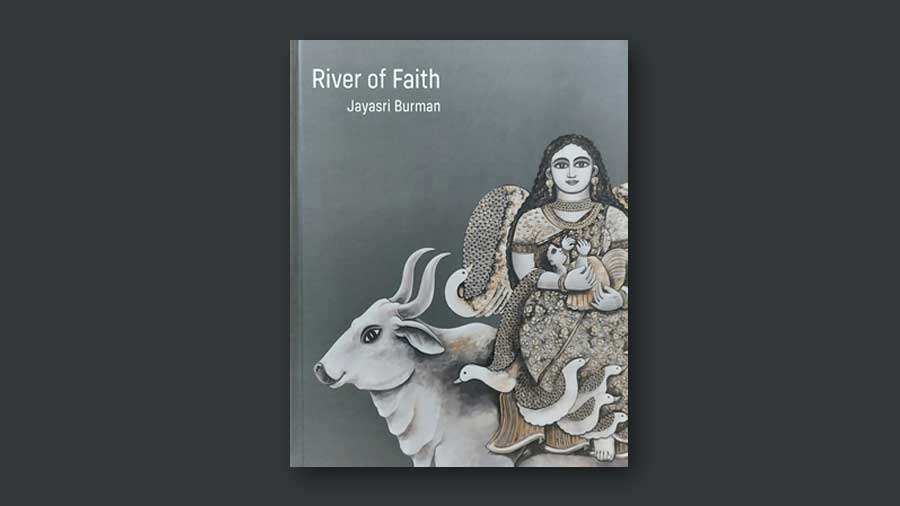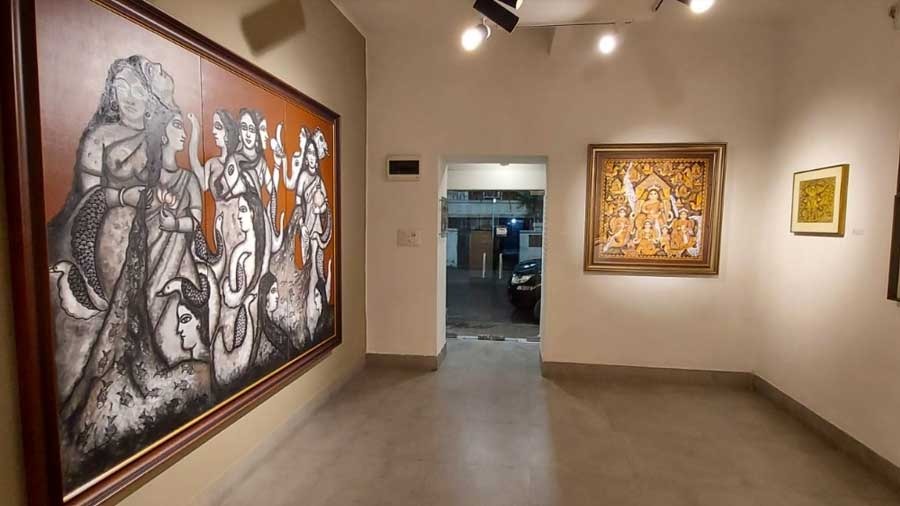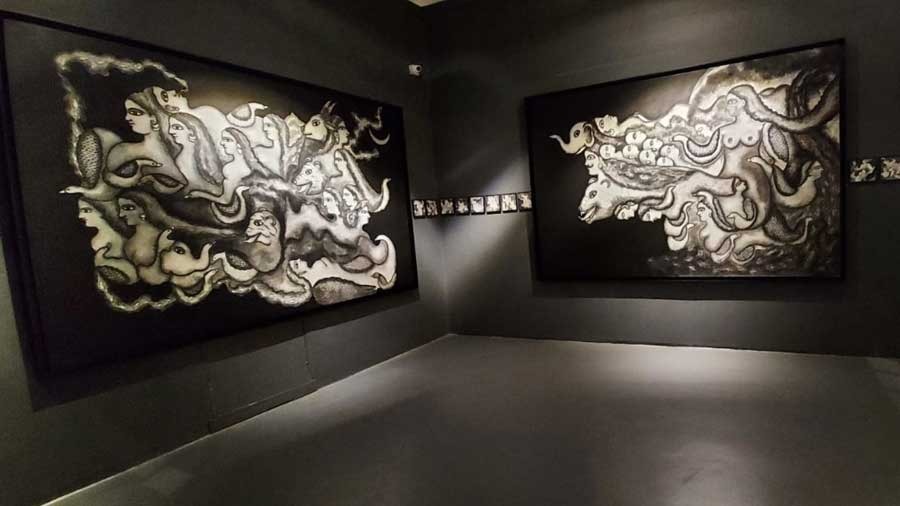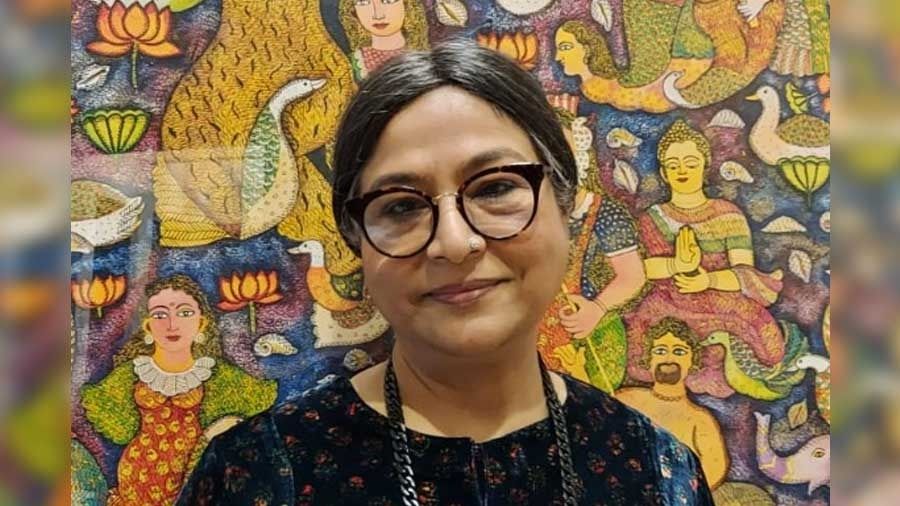Jayasri Burman is a name to reckon with in the milieu of Indian contemporary art. Her work blends history, folklore, mythology and feminism in compelling frames that resonate with audiences both in the country and abroad. Her latest offering is the breathtakingly ambitious and incredibly detailed River of Faith, a tribute to the Ganges which is the life force of India, connecting its inhabitants across space and time. In her imagination, the Ganga assumes many forms, embodying both fantasy and reality, fertility and ferocity, origin and annihilation, hope and despair. Her unique stylisation creates a visual language that allows for exciting new modes of perception.
Excerpts from an exclusive tete-a-tete with the artist about the ebb and flow of her latest creation, on display at Art Exposure Gallery, on Mahanirban Road in South Kolkata, till March 1.

‘River of Faith’ is on display at Art Exposure Gallery, on Mahanirban Road, till March 1
Debnita Chakravarti: Your magnum opus titled River of Faith is resplendent in your unique vibrant imagery of metaphors and natural elements that emerge as symbols and allegories of personal interpretations. Where and why did you set sail along these intriguing waters?
Jayasri Burman: The origin of this special riverine escapade of mine lies in the practice of my father when on special occasions I accompanied him to river ghats. Baba would bathe there and he would also perform a havan. That was like a theatre of life for me. There were so many people, some of whom would be crying, some would be immersed in their pujas, chanting shlokas, enjoying a massage, performing suryapranaam – there were so many things that were playing out all together. The seeds of curiosity were sown in my mind and I began to ponder over why people would or could do all these things together. What was the reason behind this admixture of varied activities?
That was the point from which I began searching for answers – my moment of soul searching so to say. I recall coming back with a heavy heart, beset with endless questions. These thoughts and queries continued to come back to me in my moments of solace or otherwise.
One fine morning in 2014, I received a phone call from my father. As soon as I had picked up the phone, he began reciting the poem Ganga. I regret not remembering the words right now but I do recall the tone and intonation of his utterances. That tune, his tone left me mesmerised and also served to awaken a flood of emotions in me. He then proceeded to ask me when I would visit him. He fell ill the day after I reached him, then slipped into a coma, and passed away.
My search for answers began anew after this. I was now the daughter who sought answers about her father’s last actions. Ganga now began to flood me with a whole range of emotions. But it’s also true that I had begun drawing and painting Ganga since 2002. Thus, Ganga had been seeping into my soul and it blossomed in the years 2018-19-20, finally emerging in all its splendour in 2021. Then all my experience, my thought process, my pain, my belief and of course my solution also burst out all together, much like a volcano would. That would describe this incredible journey of mine.

Burman’s works on display at the exhibition
By what you just said one can understand why and how these primary tributaries are merging into this river of art of yours. Do you think there is any one strand which goes beyond and is more powerful than the others?
Not more powerful but in all the mythological stories that we come across we realise that there is the existence of some primordial power. As human beings we crave to see something before us. It is our human limitation that leads us to give some form or shape to this primordial power. From formless thus comes a form. The formless is what is in our thoughts and beliefs while the form is purely how we will believe that thought. Thus, form is the reflection of our thoughts and our beliefs. I have always been searching for answers on many issues and this is how Ganga entered my life.
As I read and learned more and more about Ganga, I realised how powerful she actually has been. In one of my paintings, namely Nandini, I have depicted the beautiful Nandini who was in captivity outside Kapilmuni’s ashram. Her beauty charmed the Ashtadevatas who conspired to steal her from there. This enraged Kapilmuni and he cursed the whole lot saying that they would have to be born as humans. The Ashtadevatas including Lord Indra panicked and sought Lord Shiva’s help in appeasing the sage. Shiva suggested that they appeal to Ganga and seek her help, as I have visualised and depicted in my other painting titled ‘Prarthana’.
This goes to show how powerful, how pure Ganga has been that only she could offer them a way out. She marries Shantanu and then goes to Earth on their behalf. Thereafter seven times she conceived and each time she set the child afloat. Her selfless sacrifice to give moksha to the Ashtadevatas is something that is understandably hard to encompass.
Coming back to my art, it’s tales like these that taught me how to think. The more you grow, the more you think, the more you learn. Folklore as you can see is similar the world over and in all the underlying message is that you must stay and exist in harmony with Nature. Nature is the force that drives the world, so as humans we must live in harmony with Nature and quell violent thoughts and actions. That is the universal law.

The creative force is always perceived as a feminine form. Is that why the female form is so important in your work?
Actually, Ardhanarishwar is proof that within one life form an individual always carries the male and the female elements…. We feel proud that women are scientifically born to be like this. Feminism is like that – you feel proud of being female and you continue to revel in this feminism. You revel in the fact that you are strong. My feminist is like this. They can fight it out, they can embrace it and in every which way they remain so very powerful. The dynamism that one may perceive in my works exemplifies this belief of mine. Again, you may notice the turbulence of the river in my work wherein the female form flows out and merges with other life forms.
This collection is easily the sum total of the many emotions that engulfed me at those times. Why were people becoming so negative when nature was doing its utmost to put its best foot forward and give us sunrises, sunsets, blue skies and rain and clouds and everything else – why are we not being appreciative?

From your words it is more than obvious that what you depict is all very real, but there is also a deep sense of optimism. And this is brought out by your fascinating use of bold colours. How instrumental has colour been to your art?
Yes, colours have always helped me. All colours have their own individualised expressions. But it always depends on how they have been used. For instance, the colour red can be used in different ways. It can be used for holy occasions, again it can be used for violent portrayals – it depends entirely upon the user. All the colours of the world are admixtures and so one exists not for one’s own individuality but as the amalgamation of others. The artist or the individual thus must feel it within themselves for their perfect depiction. This then is an extremely emotional individualised space governing the state of the mind and existence.

And how does one who has traced the history of the evolution of this great river so beautifully see its future? What is your personal ‘seek’ in this river-based journey?
See, Nature has her own force and remedial capabilities. No one can stop the river and all that needs to be will be borne away by her. That has been our belief. That is our “River of Faith”. This brings me back to my childhood connect of so many varied things happening in her presence. The river is our belief in faith within which all our earthly needs are fulfilled. She remains our closest connection to the primordial power that we all crave to be with. This unseen, all-encompassing force is worshipped by people in their own ways. These are the connections. These represent the many ways by which we attempt to reach out and perhaps be attuned to the greatest primordial power in the universe. This is the peace that we all seek, history and mythology give us the lesson to attain the same. Timeless connections across generations are thereby provided through the river as she continues to flow, unbridled, unfathomable.
Dr Debnita Chakravarti is associate professor of English and PG Coordinator at Shri Shikshayatan College. She has an abiding interest in ‘reading’ art and meeting artists.
